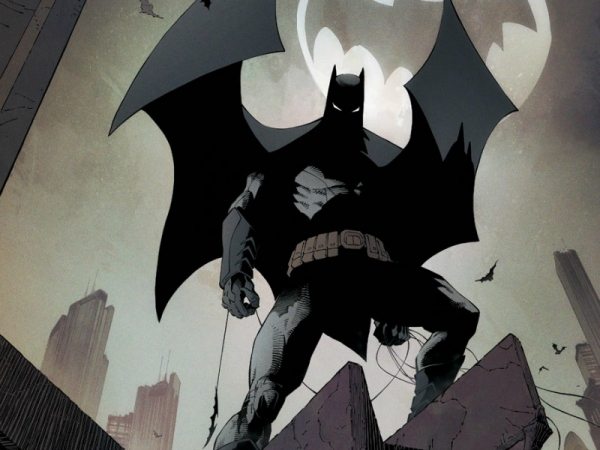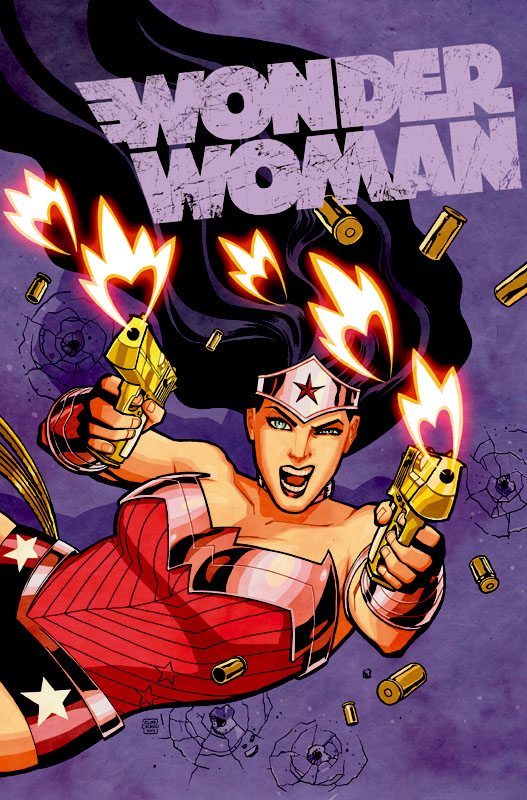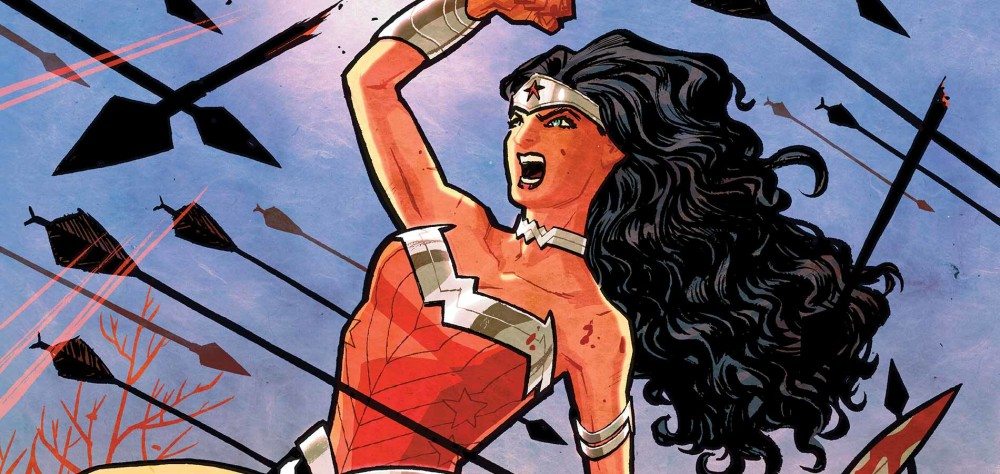
Corrina: This is a tale of the best and worst of times for DC.
Batman is the titan of the DC universe, especially in sales, but also in creative teams. There’s no more high-profile job in DC than as a creator on what has become DC’s flagship comic. (Yes, even over Detective Comics.) That held true even after DC rebooted its universe for the new 52. Batman emerged from the reboot with most of his history and supporting cast intact.
The same wasn’t true for Wonder Woman. Princess Diana was completely rebooted with the new 52, that after two other recent reboots, and the result was a gutting of alll her history and all her previous supporting casts. How can you bond readers to a character if you continually reboot her, with each change moving her further and further from her essential self? I’ve dubbed this version Princess McStabby Sword.
But let’s take an in-depth look: (And for our reviews of the rest of this week’s DC Comics, read our recaps.)
Batman #50, Scott Snyder, writer, Greg Capullo, pencils, Danny Miki, inks, Yanick Paquette, epilogue art
Ray: 10/10 (Book of the Week)
Corrina: Superb.
Ray: It’s been just under a year since Jim Gordon’s tenure as Batman began, and his entire run – and the closing arc of Snyder and Capullo’s tenure on Batman – has been entirely devoted to one story, the battle for Gotham against Mr. Bloom. So given that, this finale was going to have to be something spectacular. Does it justify the long arc? Beyond a shadow of a doubt. Following in the footsteps of epic final issues like Green Lantern #20 and Secret Wars #9 (although the creative team has an epilogue issue next month), this final chapter delivers a ton of action and some spectacular character moments as the two Batmen finally join forces to take down the monster who has made Gotham into his own personal twisted garden.
Batman, back at his physical peak and ready to take back Gotham, is at his best, but it’s Gordon – beaten, bloodied, dying, but just as determined as ever – who really steals the show, proving that while he may not have been an ideal Batman, he’s never been anything less than a hero. We finally find out the origin of Mr. Bloom – sort of, because the person behind the mask is never truly revealed – via a shocking betrayal and an act of heroism by Duke Thomas. I love the twist, that Mr. Bloom is essentially an anonymous monster brought into existence by another person’s misguided grief.
In the middle of a series of epic action sequences, as the two Batmen turn Gotham itself against Bloom, there’s occasional great scenes of dialogue, such as Alfred and Bruce’s first conversation over the Bat-com, or the surprising shades of character that Geri Powers gets this issue. And even though I knew it wouldn’t happen, it’s a testament to Snyder’s writing that I actually wondered a few times if Jim was going to make the ultimate sacrifice here. Thankfully, that is not the case – he comes out intact with both his old job and old mustache returning, and potentially a deeper friendship with Batman.
The three biggest players – Bruce, Jim, and Duke – all wind up ready to turn the page onto a new era of their lives by the end of the issue, and I can’t wait to see what comes next. It’s a typical of the Snyder/Capullo run that an issue full of horror and disturbing visuals manages to end on a genuinely hopeful note. Brilliant.
What more can be said about the Snyder/Capullo run as a whole? It’s a masterpiece. They gave us the most intriguing new villains for Batman in a generation in the Court of Owls (one of the high marks of the series), and arguably the most terrifying Joker story ever in Endgame. Snyder introduced us to two intriguing new Bat-kids in Harper and Duke (and if you consider Batman: Eternal as part of their run, gave us back Cass, Steph, and Azrael in authentic form), and ended on a high with a shockingly good and original replacement hero story. Were there some bumps along the way? Sure. Death of the Family started out as a Severed-inspired creepshow and ended as a glorified prequel for Endgame, and Zero Year went on too long.
But on a whole, this run has been far and away the best of any in the New 52, and they’re the only writer/artist team to start and end the New 52 on the same book. One epilogue issue to go, and then this run joins other iconic runs in legend. Thanks for the ride, Scott Snyder and Greg Capullo. You’ve left some enormous Bat-boots to fill.
Corrina: I knew I was going to enjoy this climax of Jim Gordon as Batman with this exchange between Batman and Gordon, just as Bruce Wayne/Batman has dramatically entered the story:
Batman: Hello, Jim, who died and made you Batman?
Gordon: Heh.
What surprised me about this landmark issue is how much it centered on Jim Gordon. I’d assumed since this was Bruce’s big comeback from the land of the dead/memory lost that the issue would focus on him saving the day. Instead, he shares the spotlight with Gordon, as they both work to halt Mr. Bloom’s plan to pull out all the weeds in Gotham City. It’s not quite a sane plan, given that this likely entails destroying the city, but there you go. Bloom is essentially the city gone made for grief.
Near the end, as he’s near-death, Jim Gordon gives a speech near the end about the nature of heroism, and of Batman, that recalls Steve Rogers at his most inspirational. So, as one of the two most fervent Jim Gordon fans in the universe, I salute you, creative team, for doing so right by him, and so right by the other cast members as well.

I realize I’m in the minority here but I’ve enjoyed the past year of Gordon as Batman more than the rest of the Snyder/Capullo run. Ray has amazing words for Endgame but while I like the idea that Gotham essentially “creates” its own villains and heroes, I have never liked Joker as Batman’s mirror-self, nor as his ultimate foe. This, of course, doesn’t mean the story wasn’t quality, for it surely was, and I love that it gave us a glimpse of what Bruce Wayne would be like if he’d never become Batman. This may be the best characterization of Bruce Wayne (not Batman) since Denny O’Neil wrote him in the 1970s.
However, I cannot bring myself to gush over Zero Year. The story deserves credit for introducing Duke Thomas, who should be a mainstay of Batman comics for a long time, and I’ve always like the Riddler as a criminal mastermind but Zero Year became increasingly ridiculous as time went on. Too many fake-outs before defeats, that Gotham could be turned into a forest in a year strained my credulity, and I believe the episode where Batman fights a lion was the one where I threw up my hands and wondered when it would be over.
It also must be said that I thought the “overreaching Court of Owls controls Gotham and always has and always will,” made the throw up my hands in aggravation. It’s my least favorite comic plot and I thought it made Batman, supposedly the world’s greatest detective, an idiot for failing to see what was under his nose. I recognize I’m in the minority on this one, however.
Still, even with the stories I didn’t like, Snyder/Capullo always wrote engaging characters, splashed tremendous visuals across the screen, and produced a definitive run.
Take a bow, creators.

Wonder Woman #50, Meredith Finch, writer, David Finch and Johnny Desjardins, pencillers, Scott Hanna, art
Ray – 5/10
Corrina: It’s Not Totally Terrible?
Ray: It’s definitely a different story for this week’s other anniversary comic, which feels very much like an oversized standard issue of Wonder Woman, mid-arc. There are some big events taking place, but none of them feel very surprising. We know that Zeke, the reincarnation (and son) of Zeus, is sick, and the other Gods are acting more and more oddly. Diana forms a pact with Hecate to heal Zeke in exchange for fetching her some extremely rare items, and that leads her to Hephaestus’ forge, where she finds out that he’s abusing and tormenting his Cyclops slaves. Her quest then takes her to a faraway mountain to confront Typhon, the father of all monsters, but along the way she’s confronted by the resurrected Ares, who goads her into a pointless confrontation as he attempts to reclaim the powers of the God of War.
This all ends with Diana riding a giant snake back to Olympus, so it’s not all bad. The main story is moderately entertaining and has some cool visuals courtesy of David Finch’s art, but it just feels like another segment in the main story. The backup, focusing on Donna Troy, has an odd mean streak to it as it seems to have some odd ideas about fate. A teenage boy has to get killed to expose a pervert’s kidnap dungeon? And this is a happy ending that gives Donna peace? Very odd.
For the run as a whole, I know opinions on the Azzarello/Chiang run that kicked things off were mixed. For me, I agree with the criticisms on one specific twist involving the Amazons – I find very few superhero origins are ever enhanced by grim-and-gritty twists that add a veneer of murder to their past. Reminds me of Kurt Busiek retconning Krypton’s history into a bloody space empire.
However, the run as a whole? Spectacular. A huge-scale mythological epic that put Diana in the middle of a sweeping fantasy story with great art, intimidating villains, and frequent twists. Reminds me a lot of a Greek Game of Thrones. It wasn’t a traditional Wonder Woman story in any way, but it was an incredibly unique and exciting story. The current run? Less so. It kept a lot of the same plot devices, but the storytelling became much more conventional. Not to mention, mass murderer Donna Troy? How many former Teen Titans need to become killers all of a sudden? The sooner that particular character element is swept under the rug, the better.
Corrina:: There’s not much to say about the 50th issue itself except it wasn’t completely terrible, and it was, at times, moderating entertaining, as Ray said. I had the feeling reading that this issue may lead to some new revelations about the gods and the Amazons and maybe DC might be throwing in retcons of the previous run? Yet, I’m not sure what that would accomplish.
I would be oh-so-happy if DC simply canceled this comic, made The Legend of Wonder Woman their main Wonder Woman comic and put its creators on the job for as long as they want. I can’t believe it took so many years for a story of that quality featuring Wonder Woman to be released and it’s not even in her main comic. :sigh:
As to the second story, featuring Donna Troy in her new role as one of the “Fates” of myth, it has to be one of the single most depressing superhero comics ever. It’s certainly the most depressing Donna Troy story ever, even over the death of her young son so many years back. (A horrible story too but not this level of horrible.)
Donna’s only choices are “bad” and “worse. The fate of a boy is to die to reveal some wrong-doing by someone else. It has to be the most wrong-headed idea of what a superhero is, ever. To wash out the taste, I went and re-read Jim Gordon’s speech from Batman #50 again. There. Much better. Meanwhile, somewhere, Donna Troy is sighing and wondering “I came back from limbo for this?”
But, onto the previous creative team, as it cannot be argued that the Azzarello/Chiang isn’t quality because one only has to point to Chiang’s amazing visuals–so suited to Wonder Woman–to know that it was. Chiang may be the best artist Wonder Woman has ever had and that saying something, given two of the others are the great George Perez and Phil Jimenez.

There’s no question the run was well-written. It was. The reimagining of Greek mythology gave it an epic feel, and there were such wonderful touches, like the magical guns that fired spells rather than bullets.
The problem is that it wasn’t a Wonder Woman story. It was a Greek mythology story that basically happened around someone named Wonder Woman who sometimes resembled the previous Wonder Woman and sometimes not. Then there’s the retcon that made Wonder Woman yet another one of Zeus’ bastard children, to give Wonder Woman “daddy issues,” which is all sorts of wrong-headed.
The kicker was making the Amazons themselves seducers, murderers, and then baby-slavers. If Wonder Woman is supposed to represent compassion and peace, though she’ll fight if need be, how did she absorb those qualities from a society that sells babies? That’s not just frustrating for a Wonder Woman reader, that’s a serious problem with the worldbuilding.
I’m also not fond of the twist that turned Wonder Woman into the God of War. It was an intriguing idea but it’s completely fallen flat in the hands of all creative teams who tried to use it.
But, TL;DR.
Instead: go buy Legend of Wonder Woman. And, by all means, find prints of Chiang’s covers from his time on the book. They’re amazing.




